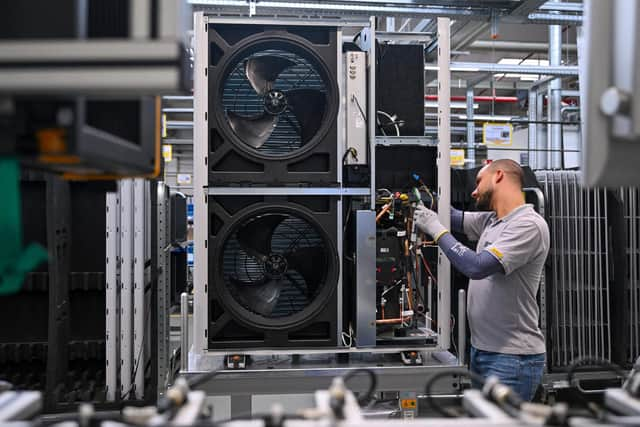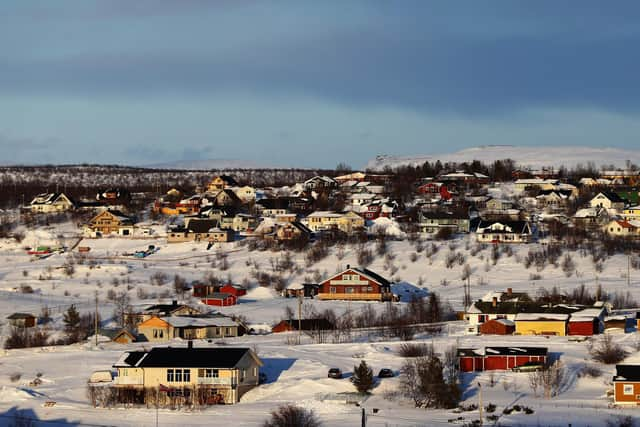Why is the UK lagging behind other countries in heat pump installation?
When Pat Pineau installed a heat pump in her rural property in the US state of Maryland in 1980, she was not considered an early adopter of the technology, which was then almost unheard of in the UK.
"We built the house pretty much in the middle of one of the first energy crises,” says Ms Pineau. “Everybody was concerned about gas prices, which were super high, so people started to skew away from oil and more and more people were going to heat pumps.”
Advertisement
Hide AdAdvertisement
Hide AdNow, North America has the largest capacity of heat pumps installed used for heating buildings of anywhere in the world. In the United States, heat pumps overtook gas furnace sales last year for the first time, while the number of apartments using heat pumps as their primary heating technology more than doubled between 2015 and 2020.


Meanwhile, in Japan, more than 90 per cent of homes are already equipped with heat pumps for space heating and cooling, while in Australia and New Zealand, air-to-air heat pumps are already the most common source of heating. Europe saw a record year for heat pump sales last year, growing by nearly 40 per cent.
This is in stark contrast to the UK, where heat pump technology is lagging. According to figures from the European Heat Pump Association, only 1.9 heat pumps per 1,000 households were sold in Britain last year – compared to 69.36 per 1,000 in Finland and 59.87 in Norway.
The Scottish Government has said it plans to prohibit the installation of gas boilers in new buildings from spring next year and has set a target date for net zero emissions of all greenhouse gases by 2045.
UK-wide, the government plans to have 600,000 heat pumps a year installed by 2028 – however, only 55,000 were fitted in 2021.


Ms Pineau believes one reason heat pumps are common in the US is because of the extreme summer and winter temperatures, which require homes to have both heating and cooling systems.
“One of the reasons it is so popular here is that you only need to have one system, you just flip a switch from heating to air conditioning,” she says.
Overall, heat pumps used as a main heating device, cover around 10 per cent of heating needs in buildings globally, meaning that one in ten homes that require substantial heating are currently served by heat pumps, according to the latest analysis from the International Energy Agency (IEA).
Advertisement
Hide AdAdvertisement
Hide AdThe technology, which draws warmth from the outside air or ground, producing 3kWh or more of heat for every kWh of electricity used to power them, is regarded as the best alternative to gas and oil heating, which most governments have said they hope to phase out.
Technology has changed dramatically since Ms Pineau installed her heat pump 43 years ago. Data from the IEA shows sales of air-to-water models, which are compatible with typical radiators and underfloor heating systems – rather than the air to air systems which pump out warmed or cooled air into a house - jumped by almost 50 per cent in Europe last year.
“When we first built the house, I tried to get a ground loop system, where you bury the heat exchanger coils three feet down in the earth, where it's 55 degrees [13C] year round,” she says. “So you only have to lift the temperature up to 70 degrees in the winter and drop it down by the same amount in the summer.
"But when I did it, it was almost unheard of and the County [local authority] didn’t know about it to grant permission. But now it's all the rage.”
Some countries, such as Norway, which has the most heat pumps per capita in Europe, have already banned fossil fuel domestic heating systems, while Germany will ban installations of fossil fuel boilers in existing buildings in 2024 and the Netherlands in 2026. The UK hopes to do so by 2035.
Grants of up to £7,500
Grants are available from the government to contribute towards heat pump installations, up to £7,500 in Scotland and £6,000 in England and in Wales. Globally, financial incentives are available in over 30 countries around the world.
In written evidence submitted to the UK Government in December last year, experts from the IEA told MPs that France is spending three times more per year on their heat pump subsidy scheme than the UK. Both France and Germany offer grants of up to euro 15,000 (£13,000), depending on the type of heat pump. However, in most European countries, many grants for individual households are lower.
Oliver Joy, spokesman for the IEA, says the average subsidy across all nations offering incentives makes the cheapest heat pump options comparable to the cost of a new gas boiler for many consumers. However, subsidies do not seem to necessarily tally with higher uptake.
Advertisement
Hide AdAdvertisement
Hide Ad"Progress varies country by country as does the preferred type of heat pump technology,” he says. “For example, in France, heat pumps outsold fossil fuel boilers in buildings for the first time in 2022, coinciding with the first year of a national ban on gas boilers in new buildings. But in Germany and Italy, there were twice as many fossil fuel boilers sold than heat pumps last year. All three of these countries accounted for the majority of new sales last year, but many European countries already have incentives for heat pumps, primarily to support with the upfront cost of the technology and installation.
He adds: “Global sales of heat pumps last year grew 11 per cent. However, new sales need to expand by well over 15 per cent per year this decade if the world is to achieve net zero emissions by 2050.”
Experts say one of the big disincentives for heat pump take up in the UK is value for money. It costs around £10,000 to buy and install a heat pump. However, unlike in many other countries, the cost of electricity is not dramatically cheaper per unit than gas, making running costs only marginally cheaper.
Mr Joy says: “The cost of production whether from electricity or gas is highly dependent on the energy mix and electricity market design. In some locations the price of gas and electricity are interlinked. For instance, in places where gas is used for electricity generation, gas often sets the price for all electricity generators on the wholesale market, which then feeds down to the consumer level.
"In this regard, heat pumps are not always at a pure cost advantage relative to other technologies. That said, the biggest economic advantage of a heat pump is that it is at least two to three times more efficient than a gas boiler, which means using less energy to provide the same amount of heat – and therefore potentially lower bills over the long-term.”
‘Cheapest electricity prices in Europe’
In a report published earlier this year, the IEA warned that heat pumps are still largely absent from heating markets in Central Asia and some parts of Eastern Europe, where upfront costs remain a major barrier and many homes are connected to district heating networks. However, it said large-scale pumps are an effective option to decarbonise these networks, which remain heavily dependent on fossil fuels.
Rolf Iver Hagemoen, secretary-general of the Norwegian Heat Pump Association and a board member of the European Heat Pump Association, says the Norwegian market, where more than 50 per cent of homes have heat pumps, is very different to that in the UK and many other countries in Europe.
"There's historical reasons why not only Norway – but also Sweden and Finland - has a lot of heat pumps and the first is that we have quite a strong electric grid,” he says. “We started electrificatio quite early because we don't have the large gas infrastructure that you have in the rest of Europe.
Advertisement
Hide AdAdvertisement
Hide Ad"So all the houses in our buildings in Finland, Norway, Sweden are either heated by district heating often powered by biomass, or direct electricity heating, or heat pumps. And we have had, for decades, the cheapest prices of electricity in Europe.
"Second, is, it's profitable for householders. The payback period for an air to air heat pump can be just a few years, so you can save a lot of money by installing heat pumps.”
As a result, when the Norwegian government committed to banning fossil fuel boilers by 2020, and offered high subsidies to householders wanting to move to a heat pump from 2012, a large proportion of the population took up the offer. Now, however, subsidy schemes have been cut back and growth has slowed.
This week, Scottish Renewables warned UK and Scottish governments must urgently explain to the public why a major electricity network expansion is needed to cut bills, drive economic development and assist in the transition to net-zero.
Mr Hagemoen agrees, pointing out that even Norway is not likely to meet its ambitious climate targets, despite huge de-carbonisation of the infrastructure in the country.
“The electric infrastructure in the country as a whole [the UK] has to be upgraded [for more clean energy infrastructure using the grid such as heating and electric vehicles],” he says. “But this is a long term investment. In the short term, you have lots of buildings where you already can use heat pumps.”
In Norway, most people with a heat pump have a back up supply of electric heating for days when it gets extremely cold – the country can see sustained temperatures of minus 20 during the winter – but typically, 90 per cent of their energy needs are met by the heat pump.
"In my house, on the coldest days, especially in bedrooms if the doors are closed, we can use the direct electric heating there and we have electric floor heating in the bathroom,” says Mr Hagemoen. “However, we have been able to combine the heat pump and electricity, but in Scotland and the UK in general, with a high price in electricity, you would want the heat pump to cover as much as possible. In countries where gas has been cheap and electricity has been high in those markets, it has been difficult to get a really big growth for heat pumps.
Advertisement
Hide AdAdvertisement
Hide Ad"The challenge for you in the UK is also that the gas boiler is really cheap and the heat pump costs much more. This is where subsidy schemes are important if you want to speed up the market to gain interest from different households, because it's a higher investment cost.”
Comments
Want to join the conversation? Please or to comment on this article.
